Study on Qinghai Province Residents’ Perception of Grassland Fire Risk and Influencing Factors
Abstract
1. Introduction
2. Materials and Methods
2.1. Overview of the Study Area
2.2. Data Source
2.3. Research Methods
2.3.1. Grassland Fire Risk Perception Evaluation Index System
- (1)
- Knowledge related to grassland fires denotes residents’ capacity to acquire, retain, and process information on such events, encompassing cognitive understanding derived from education, media exposure, and practical experience. Higher levels of such knowledge facilitate more accurate risk assessments and heightened risk perception. Therefore, based on prior research, we selected the following indicators to evaluate residents’ knowledge: causes of grassland fires (K1), awareness of grassland fire hazards (K2, K3), knowledge of grassland fire escape knowledge (K4), disaster prevention and mitigation knowledge (K5), understanding of grassland fire consequences (K6), and familiarity with emergency response plans (K7).
- (2)
- Attitudes toward responding to grassland fires denote residents’ evaluations and predispositions shaped by their values, knowledge, and experience, and are readily influenced by the level of knowledge. Individuals with positive attitudes exhibit greater sensitivity and proactive responses, whereas those with negative attitudes tend to be passive. Therefore, the assessment of attitudes toward grassland fire response primarily involves indicators such as sensitivity to fire hazards (A1), participation levels and social trust (A2, A3), self-evaluation of behavior (A4), and attentiveness to relevant information (A5).
- (3)
- Individual responses to grassland fires denote the risk mitigation measures adopted by residents when confronted with fire threats. Variations in knowledge and attitudes shape behavioral tendencies, with more proactive individuals being likelier to undertake defensive, rescue, and avoidance actions. Accordingly, the assessment of individual behavioral responses to grassland fires incorporates the following indicators: emergency preparedness (P1, P2) and participation in firefighting or rescue activities (P3, P4, P5).
2.3.2. Grassland Fire Risk Perception Model
- (1)
- Determine weighting.
- (a)
- Entropy rights method for rights confirmation.
- (b)
- Validation using the CRITIC weighting method
- (2)
- Calculation of grassland fire risk perception model
2.3.3. Quantile Regression and the Selection of Factors Influencing Risk Perception
2.3.4. Classification of Residents
3. Results
3.1. Grassland Fire Risk Perception
3.1.1. Evaluation of Residents’ Perception of Grassland Fire Risk
3.1.2. Dimensional Analysis of Residents’ Perception of Grassland Fire Risk
- (1)
- Knowledge related to grassland fires.
- (2)
- Attitudes toward grassland fire response
- (3)
- Grassland fire response behavior.
3.2. Factors Influencing Residents’ Perception of Grassland Fire Risk
4. Discussion
4.1. Residents’ Perception of Grassland Fire Risk and Response Behavior
4.2. Analysis of Factors Affecting Perception of Grassland Fire Risk in Qinghai Province
5. Conclusions
- (1)
- The average grassland fire risk perception score among residents in Qinghai Province was 0.509, with response behavior contributing the most, knowledge second, and attitude the least.
- (2)
- Perception levels were highest in agricultural areas, lowest in pastoral areas; residents with moderate dependency ratios and in moderately fire-susceptible zones performed best, while high-susceptibility zones showed signs of “risk desensitization.”
- (3)
- Residents of Qinghai Province show distinct variations in their perceptions of grassland fire risks and response behaviors. Agricultural regions should prioritize scenario-based training, pastoral regions’ mobile training, and early warning systems. Measures—such as demonstration projects, subsidies, and welfare incentives—should align with local dependency ratios. High-susceptibility areas require reinforced mandatory prevention, medium- and low-susceptibility areas strengthened proactive strategies. A tiered, multi-channel risk communication system, incorporating fire prevention education into school curricula, is essential for long-term sustainability.
- (4)
- Strengthening risk communication mechanisms is vital for grassland fire prevention and suppression. Effective information dissemination underpins both residents’ risk perception and collective response systems. With climate change altering fire frequency, spatiotemporal distribution, and intensity, environmental impacts must be closely monitored and risk information promptly updated. Addressing gaps in residents’ knowledge and prevention capacities through targeted guidance can shift them from passive acceptance to active engagement, improving both understanding and response capabilities.
Supplementary Materials
Author Contributions
Funding
Institutional Review Board Statement
Informed Consent Statement
Data Availability Statement
Acknowledgments
Conflicts of Interest
References
- Growth, M.F. The Elliptical Shape And Size of Wind-Driven Crown Fires. Fire Manag. 2014, 73, 28–33. [Google Scholar]
- Tedim, F.; Leone, V.; Amraoui, M.; Bouillon, C.; Coughlan, M.R.; Delogu, G.M.; Fernandes, P.M.; Ferreira, C.; McCaffrey, S.; McGee, T.K.; et al. Defining Extreme Wildfire Events: Difficulties, Challenges, and Impacts. Fire 2018, 1, 9. [Google Scholar] [CrossRef]
- Tedim, F.; Leone, V.; McGee, T.K. Extreme Wildfire Events and Disasters: Root Causes and New Management Strategies; Elsevier: Amsterdam, The Netherlands, 2019. [Google Scholar]
- Collins, T.W. What influences hazard mitigation? Household decision making about wildfire risks in Arizona’s White Mountains. Prof. Geogr. 2008, 60, 508–526. [Google Scholar] [CrossRef]
- Paveglio, T.B.; Moseley, C.; Carroll, M.S.; Williams, D.R.; Davis, E.J.; Fischer, A.P. Categorizing the social context of the wildland urban interface: Adaptive capacity for wildfire and community “archetypes”. For. Sci. 2015, 61, 298–310. [Google Scholar] [CrossRef]
- Eriksen, C.; Gill, N. Bushfire and everyday life: Examining the awareness-action ‘gap’ in changing rural landscapes. Geoforum 2010, 41, 814–825. [Google Scholar] [CrossRef]
- Lv, S. The Effect of Risk Perception on the Consumer’s Online Shopping Behaviors. Theory Res. 2010, 52, 45–47. [Google Scholar]
- Schroeder, T.C.; Tonsor, G.T.; Pennings, J.M.; Mintert, J. Consumer food safety risk perceptions and attitudes: Impacts on beef consumption across countries. BE J. Econ. Anal. Policy 2007, 7, 1–29. [Google Scholar] [CrossRef]
- Xu, D.; Peng, L.; Liu, S.; Wang, X. Influences of risk perception and sense of place on landslide disaster preparedness in southwestern China. Int. J. Disaster Risk Sci. 2018, 9, 167–180. [Google Scholar] [CrossRef]
- Lechowska, E. What determines flood risk perception? A review of factors of flood risk perception and relations between its basic elements. Nat. Hazards 2018, 94, 1341–1366. [Google Scholar] [CrossRef]
- Siegrist, M.; Árvai, J. Risk perception: Reflections on 40 years of research. Risk Anal. 2020, 40, 2191–2206. [Google Scholar] [CrossRef]
- Perić, J.; Cvetković, V.M. Demographic, socio-economic and phycological perspective of risk perception from disasters caused by floods: Case study Belgrade. Int. J. Disaster Risk Manag. 2019, 1, 31–45. [Google Scholar] [CrossRef]
- Zhang, Y.; Dong, P.; Fu, P. The Influence of Individual Characteristics on Risk Perception. In Proceedings of the 4th International Conference on Education, Knowledge and Information Management, ICEKIM 2023, Nanjing, China, 26–28 May 2023. [Google Scholar] [CrossRef]
- Kirby-Straker, R.; Straker, L. The Effect of Experiencing Disaster Losses on Risk Perceptions and Preparedness Behaviors (Natural Hazards Center Weather Ready Research Report Series, Report 8); Natural Hazards Center, University of Colorado Boulder: Boulder, CO, USA, 2023. [Google Scholar]
- da Fonseca, M.N.; da Silva, L.P.; Tedim, F. Corrigendum to “Flood risk communication: Challenges and opportunities in Brazilian cities” [Int. J. Disaster Risk Reduct., Volume 119 (2025) 105292]. Int. J. Disaster Risk Reduct. 2025, 119, 105484. [Google Scholar] [CrossRef]
- Oh, J.; Lee, D. Role of trust in government and collaboration in building disaster resilience. Soc. Sci. Q. 2022, 103, 1647–1658. [Google Scholar] [CrossRef]
- Kiymis, I.; Kaya, A.A. Development of the Disaster Risk Perception Scale: Evaluation of Its Impact on Disaster Preparedness. Disaster Med. Public Health Prep. 2025, 19, e38. [Google Scholar] [CrossRef] [PubMed]
- Cong, Z.; Feng, G.; Chen, Z. Disaster exposure and patterns of disaster preparedness: A multilevel social vulnerability and engagement perspective. J. Environ. Manag. 2023, 339, 117798. [Google Scholar] [CrossRef]
- Slovic, P. Perception of risk. Science 1987, 236, 280–285. [Google Scholar] [CrossRef]
- Renn, O. Risk Governance: Coping with Uncertainty in a Complex World; Routledge: Oxfordshire, UK, 2017. [Google Scholar]
- Chu, W.; Zhang, W.; Wu, X.; Zhang, J.; Liu, S.; Wang, X. Relationship Research Between Public Risk Perception on Extreme Precipitation and Floods and Protective Behavior Motivation—The Case of Aksu Region, Xinjiang. J. Catastrophology 2022, 37, 227–234. [Google Scholar]
- Feng, D.; Ning, L. Factors of Public Risk Perception of Geological Hazards in Mining Areas—Take Fushun West Opencast Mining Area as an Example. Sci. Technol. Dev. 2020, 16, 901–908. [Google Scholar]
- Tian, L.; Tu, J. Earthquake Risk Perception and Its Influencing Factors in Rural China: A Case Study on Survey Data in Chuxiong of Yunnan Province. Insur. Stud. 2014, 35, 59–69. [Google Scholar]
- Mai, N.T.; Truong, D.D. Farming Households’ Perception on Natural Disaster Impacts to Livelihoods and Adaptation Practices: A Case Study of Coastal Provinces in Central Vietnam. Int. J. Sustain. Dev. Plan. 2022, 17, 579–592. [Google Scholar] [CrossRef]
- Dada, O.A.; Angnuureng, D.B.; Almar, R.; Morand, P. Linking human perception and scientific coastal flood risk assessment (Anlo Beach Community, Ghana). Ocean Coast. Manag. 2023, 243, 106758. [Google Scholar] [CrossRef]
- Sheu, J.-B. Mass evacuation planning for disasters management: A household evacuation route choice behavior analysis. Transp. Res. Part E Logist. Transp. Rev. 2024, 186, 103544. [Google Scholar] [CrossRef]
- Oubennaceur, K.; Chokmani, K.; Lessard, F.; Gauthier, Y.; Baltazar, C.; Toussaint, J.-P. Understanding flood risk perception: A Case Study from Canada. Sustainability 2022, 14, 3087. [Google Scholar] [CrossRef]
- Cisternas, P.C.; Cifuentes, L.A.; Bronfman, N.C.; Repetto, P.B. The influence of risk awareness and government trust on risk perception and preparedness for natural hazards. Risk Anal. 2024, 44, 333–348. [Google Scholar] [CrossRef]
- Wang, C.; Yin, J. Analysis of the Flood Risk Perception and its Influence Factors of Shanghai Residents. J. Catastrophology 2022, 37, 149–154. [Google Scholar]
- Zhang, Y.; Tian, M.; Shen, Y.; Qiu, Y.; Li, K. Study on Farmers’ Drought Risk Perception in Yunnan Plateau Mountain: A Case Study of Yuanmou County. Areal Res. Dev. 2021, 40, 156–160. [Google Scholar]
- Li, J. Evaluation on public risk perception: A case study on college students. J. Nat. Disasters 2005, 14, 153–156. [Google Scholar]
- Khan, A.A.; Rana, I.A.; Nawaz, A. Gender-based approach for assessing risk perception in a multi-hazard environment: A study of high schools of Gilgit, Pakistan. Int. J. Disaster Risk Reduct. 2020, 44, 101427. [Google Scholar] [CrossRef]
- Yildiz, A.; Teeuw, R.; Dickinson, J.; Roberts, J. Children’s earthquake preparedness and risk perception: A comparative study of two cities in Turkey, using a modified PRISM approach. Int. J. Disaster Risk Reduct. 2020, 49, 101666. [Google Scholar] [CrossRef]
- Bodas, M.; Peleg, K.; Stolero, N.; Adini, B. Risk perception of natural and human-made disasters—Cross sectional study in eight countries in Europe and beyond. Front. Public Health 2022, 10, 825985. [Google Scholar] [CrossRef]
- Ng, S.L. Effects of risk perception on disaster preparedness toward typhoons: An application of the extended theory of planned behavior. Int. J. Disaster Risk Sci. 2022, 13, 100–113. [Google Scholar] [CrossRef]
- Su, F.; He, C.; Huang, J.; Guo, Z. Current Situation and Trend of Hazard Risk Perception. J. Catastrophology 2016, 31, 146–151. [Google Scholar]
- Zhou, X.; Wang, Y.; Zheng, C.; Li, X.; Dong, Z. Study on Flood Risk Awareness and Influencing Factors of Greenhouse Growers: A Case Study in Shandong Province. J. Catastrophology 2021, 36, 215–220. [Google Scholar]
- Rana, I.A.; Jamshed, A.; Younas, Z.I.; Bhatti, S.S. Characterizing flood risk perception in urban communities of Pakistan. Int. J. Disaster Risk Reduct. 2020, 46, 101624. [Google Scholar] [CrossRef]
- Wang, Z.; Zhang, F.; Liu, S.; Xu, D. Consistency between the subjective and objective flood risk and willingness to purchase natural disaster insurance among farmers: Evidence from rural areas in Southwest China. Environ. Impact Assess. Rev. 2023, 102, 107201. [Google Scholar] [CrossRef]
- Huang, H.; Wang, R.; Xiao, Y.; Li, Y.; Zhang, Q.-F.; Xiang, X. Determinants of People’s Secondary Hazards Risk Perception: A Case Study in Wenchuan Earthquake Disaster Areas of China. Front. Earth Sci. 2022, 10, 865143. [Google Scholar] [CrossRef]
- Zhou, Q.; Liu, D. Evaluation of flood risk perception of Chinese residents based on KAP model. Yangtze River 2019, 50, 28–34+97. [Google Scholar]
- Cui, F.; Liu, Y.; Chang, Y.; Duan, J.; Li, J. An overview of tourism risk perception. Nat. Hazards 2016, 82, 643–658. [Google Scholar] [CrossRef]
- Hungerford, H.R.; Volk, T.L. Changing learner behavior through environmental education. J. Environ. Educ. 1990, 21, 8–21. [Google Scholar] [CrossRef]
- Gu, X.; Li, X.; Xu, D.; Fan, S.; Zhou, X.; Zhu, Q. Responses of urban residents to rural multifunctional transition in the peri-urban areas: Analysis based on the “Knowledge-Attitude-Behavior”(KAP) Model. Geogr. Res. 2023, 42, 1598–1612. [Google Scholar]
- Baranowski, T.; Cullen, K.W.; Nicklas, T.; Thompson, D.; Baranowski, J. Are current health behavioral change models helpful in guiding prevention of weight gain efforts? Obes. Res. 2003, 11, 23S–43S. [Google Scholar] [CrossRef]
- Hou, S.-I. Health education: Theoretical concepts, effective strategies and core competencies. Health Promot. Pract. 2014, 15, 619–621. [Google Scholar] [CrossRef]
- Xu, M.; Zhang, Z. Farmers’ knowledge, attitude, and practice of rural industrial land changes and their influencing factors: Evidences from the Beijing-Tianjin-Hebei region, China. J. Rural Stud. 2021, 86, 440–451. [Google Scholar]
- Xu, W.; Zhou, Q.; Ma, W.; Huang, Y. Analysis of the Spatial Distribution Pattern of Grassland Fire Susceptibility and Influencing Factors in Qinghai Province. Appl. Sci. 2025, 15, 3386. [Google Scholar] [CrossRef]
- Huang, Y.; Xia, X.; Zhou, Q.; Pan, Y.; Chen, Y.; Li, H. Spatial and Temporal Patterns and Causes of Grassland Fires in Qinghai Province. Prog. Geogr. 2023, 42, 1973–1983. [Google Scholar] [CrossRef]
- Zhou, X.; Xu, W.; Yuan, Y.; Ma, Y.; Qian, X.; Ge, Y. Overview on Research Methods and Application of Hazard Risk Perception. J. Catastrophology 2012, 27, 114–118. [Google Scholar]
- Bubeck, P.; Botzen, W.J.W.; Aerts, J.C. A review of risk perceptions and other factors that influence flood mitigation behavior. Risk Anal. Int. J. 2012, 32, 1481–1495. [Google Scholar] [CrossRef]
- Grothmann, T.; Reusswig, F. People at risk of flooding: Why some residents take precautionary action while others do not. Nat. Hazards 2006, 38, 101–120. [Google Scholar] [CrossRef]
- Bai, D.; Cao, Y.; Zhang, Y. Temporal and spatial distribution of extreme precipitation in Qinghai Province in recent 60 years. Yangtze River 2022, 53, 59–64. [Google Scholar]
- Jiang, L.; Fu, L.; Wang, Y.; Wang, Y. Risk perception of rural inhabitants and their capacity to respond to typhoon. Chin. Rural Health Serv. Adm. 2011, 31, 715–717. [Google Scholar]
- Liu, X.; Shang, Z. Risk analysis methods of natural disasters and their applicability. Prog. Geogr. 2014, 33, 1486–1497. [Google Scholar]
- Savadori, L.; Savio, S.; Nicotra, E.; Rumiati, R.; Finucane, M.L.; Slovic, P. Expert and public perception of risk from biotechnology. In The Feeling of Risk; Routledge: Oxfordshire, UK, 2013; pp. 245–260. [Google Scholar]
- Yang, W.; Luo, J.; Zhou, Z. Emotional State, Interest in the Information and Perception of Earthquake Risk. Insur. Stud. 2014, 35, 61–71. [Google Scholar]
- Li, H.; Fan, C.; Jia, J.; Wang, S.; Hao, L. The Public Perception of Risks and the Management of Emergency Measures Taken during Unexpected Calamities. J. Manag. World 2009, 25, 52–60+187–188. [Google Scholar] [CrossRef]
- Li, J.; Zhou, Q.; Yan, R. Study on index system for assessment of populace’s ability in calamity perception. J. Nat. Disasters 2002, 11, 129–134. [Google Scholar]
- Gaillard, J.-C. Alternative paradigms of volcanic risk perception: The case of Mt. Pinatubo in the Philippines. J. Volcanol. Geotherm. Res. 2008, 172, 315–328. [Google Scholar] [CrossRef]
- Cao, X.; Lei, Y.; Gong, Y.; Zhang, S.; Luo, X. Study on health assessment method of shearer based on combination weighting method. Coal Sci. Technol. 2020, 48, 135–141. [Google Scholar]
- Zhang, L.; Zhang, X. Weighted clustering method based on improved CRITIC method. Stat. Decis. 2015, 31, 65–68. [Google Scholar]
- Wu, X. Comparative analysis of three weighting methods. China Collect. Econ. 2016, 32, 73–74. [Google Scholar]
- Bosschaart, A.; Kuiper, W.; van der Schee, J.; Schoonenboom, J. The role of knowledge in students’ flood-risk perception. Nat. Hazards. 2013, 69, 1661–1680. [Google Scholar]
- Meng, W. Study on Risk Perception and Influencing Factors of Citrus Growers—A Take Xiangzhou County of Laibin City as an Exampl. Master’s Thesis, Guangxi University, Nanning, China, 2023. [Google Scholar]
- Xiao, F.; Zheng, R. Analysis of Current Chinese Research on Cognition and Decision. Adv. Psychol. Sci. 2003, 21, 281–288. [Google Scholar]
- Sun, Y.; Zhao, X. Evolution of Livelihood Resilience and Its Influencing Factors of Out-of Poverty Farmers in Longnan Mountainous Area. Geogr. Sci. 2022, 42, 2160–2169. [Google Scholar]
- Hasibuan, A.M.; Gregg, D.; Stringer, R. Accounting for diverse risk attitudes in measures of risk perceptions: A case study of climate change risk for small-scale citrus farmers in Indonesia. Land Use Policy 2020, 95, 104252. [Google Scholar] [CrossRef]
- Huang, H. Media use, environmental beliefs, self-efficacy, and pro-environmental behavior. J. Bus. Res. 2016, 69, 2206–2212. [Google Scholar] [CrossRef]
- Li, Y. Study on Livelihood Risks of Herdsmen and Their Risk-Coping Strategies in Qitai County of Xinjiang. Master’s Thesis, Xinjiang Agricultural University, Urumqi, China, 2020. [Google Scholar]
- Altarawneh, L.; Mackee, J.; Gajendran, T. The influence of cognitive and affective risk perceptions on flood preparedness intentions: A dual-process approach. Procedia Eng. 2018, 212, 1203–1210. [Google Scholar] [CrossRef]
- Hou, L.; Du, W.; Yin, S.; Yu, S. Grassland fire risk assessment based on herder scale: Taking Khan Obo village, Grassland fire risk assessment based on herder scale: Taking Khan Obo village. Acta Ecol. Sin. 2022, 42, 1059–1070. [Google Scholar]
- Kirschner, J.; Clark, J.; Boustras, G. Governing wildfires: Toward a systematic analytical framework. Ecol. Soc. 2023, 28, 6. [Google Scholar] [CrossRef]
- Kirschner, J.A.; Ascoli, D.; Moore, P.; Clark, J.; Calvani, S.; Boustras, G. Governance drivers hinder and support a paradigm shift in wildfire risk management in Italy. Reg. Environ. Change 2024, 24, 13. [Google Scholar] [CrossRef]
- Bacciu, V.; Salis, M.; Arca, B.; Pellizzaro, G.; Ascoli, D.; Delogu, G.M.; Eftychidis, G.; Chuvieco, E.; Gitas, I.; Viegas, D.X. Shifting to a holistic approach in national wildfire management policies: The Italian case. iForest-Biogeosci. For. 2025, 18, 163. [Google Scholar] [CrossRef]
- Bao, Z.; Yan, Q. The Driving Mechanism of Environmental Concern on Environmental Behavior—Based on the General Social Survey Data of Ethnic Minority Areas in Yunnan Province. J. Northwest Norm. Univ. (Soc. Sci.) 2022, 59, 120–136. [Google Scholar]
- Cui, L.; Li, C.; Jiang, B. Consumers’ perceived deviation towards the qualitative safety risk of domestic infant milk powder and its influential factors. J. China Agric. Univ. 2022, 27, 265–277. [Google Scholar]
- Tang, H.; Xu, B. Empirical attribution of consumers’ willingness of food safety governance: A moderated chain mediation model based on theory of planned behavior. Chin. J. Food Hyg. 2022, 34, 1275–1281. [Google Scholar]
- Huang, B. Study on Public Perception of Urban River Flood Risk. Master’s Thesis, Lanzhou University, Lanzhou, China, 2023. [Google Scholar]
- Gao, X. Impacting Factors of Landslides and Farmers’ Risk Perception in Hani Rice Terraces Heritage Core Area. Master’s Thesis, Yunnan Normal University, Kunming, China, 2019. [Google Scholar]
- Archibald, S.; Lehmann, C.E.; Gómez-Dans, J.L.; Bradstock, R.A. Defining pyromes and global syndromes of fire regimes. Proc. Natl. Acad. Sci. USA 2013, 110, 6442–6447. [Google Scholar] [PubMed]
- Andela, N.; Morton, D.C.; Giglio, L.; Chen, Y.; van der Werf, G.R.; Kasibhatla, P.S.; DeFries, R.S.; Collatz, G.; Hantson, S.; Kloster, S. A human-driven decline in global burned area. Science 2017, 356, 1356–1362. [Google Scholar] [CrossRef]
- Fusco, E.J.; Abatzoglou, J.T.; Balch, J.K.; Finn, J.T.; Bradley, B.A. Quantifying the human influence on fire ignition across the western USA. Ecol. Appl. 2016, 26, 2390–2401. [Google Scholar] [CrossRef]
- Luo, L.; Zhao, X.; Wang, Y.; Zhang, Q.; Xue, B. Farmers’ perception of climate change based on a structural equation model: A case study in the Gannan Plateau. Acta Ecol. Sin. 2017, 37, 3274–3285. [Google Scholar] [CrossRef][Green Version]
- Li, H.; Gong, L.; Fan, C. The Formation Mechanism of the Public’s Coping Behavior in Drug Safety Events. J. Public Manag. 2019, 16, 97–107+172–173. [Google Scholar][Green Version]
- Adger, W.N.; Vincent, K. Uncertainty in adaptive capacity. Comptes Rendus Geosci. 2005, 337, 399–410. [Google Scholar] [CrossRef]
- Kuruppu, N. Adapting water resources to climate change in Kiribati: The importance of cultural values and meanings. Environ. Sci. Policy 2009, 12, 799–809. [Google Scholar] [CrossRef]
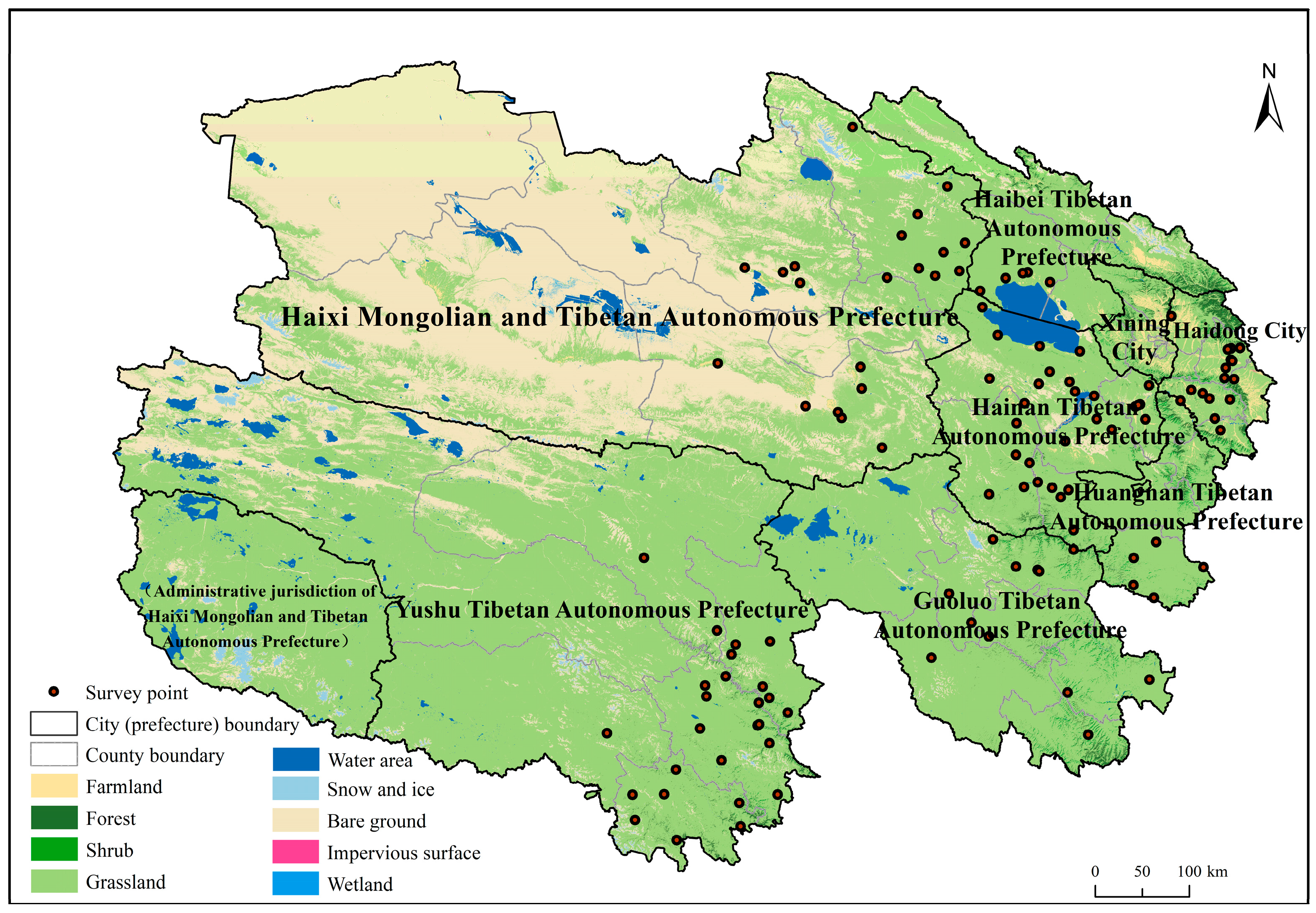
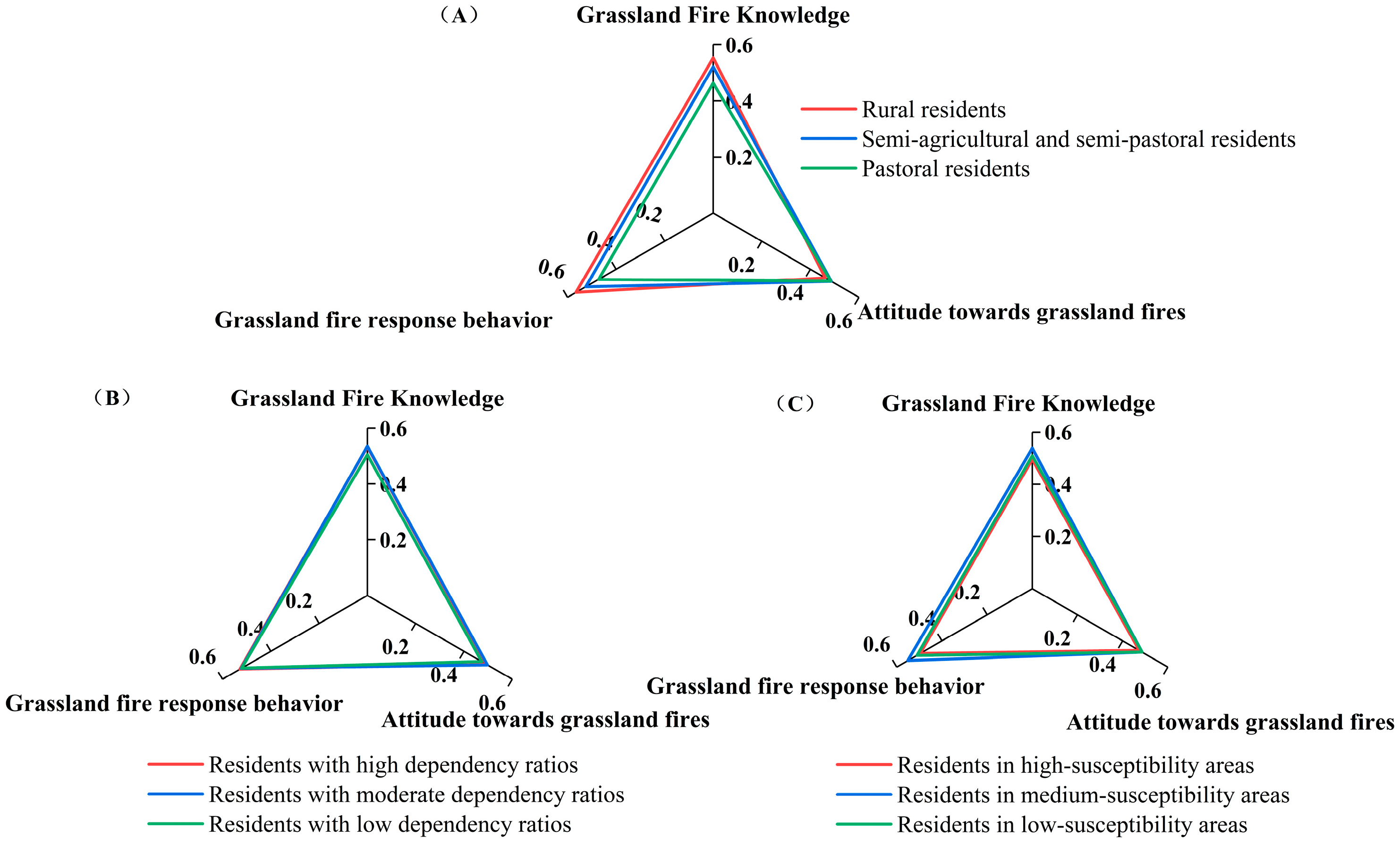
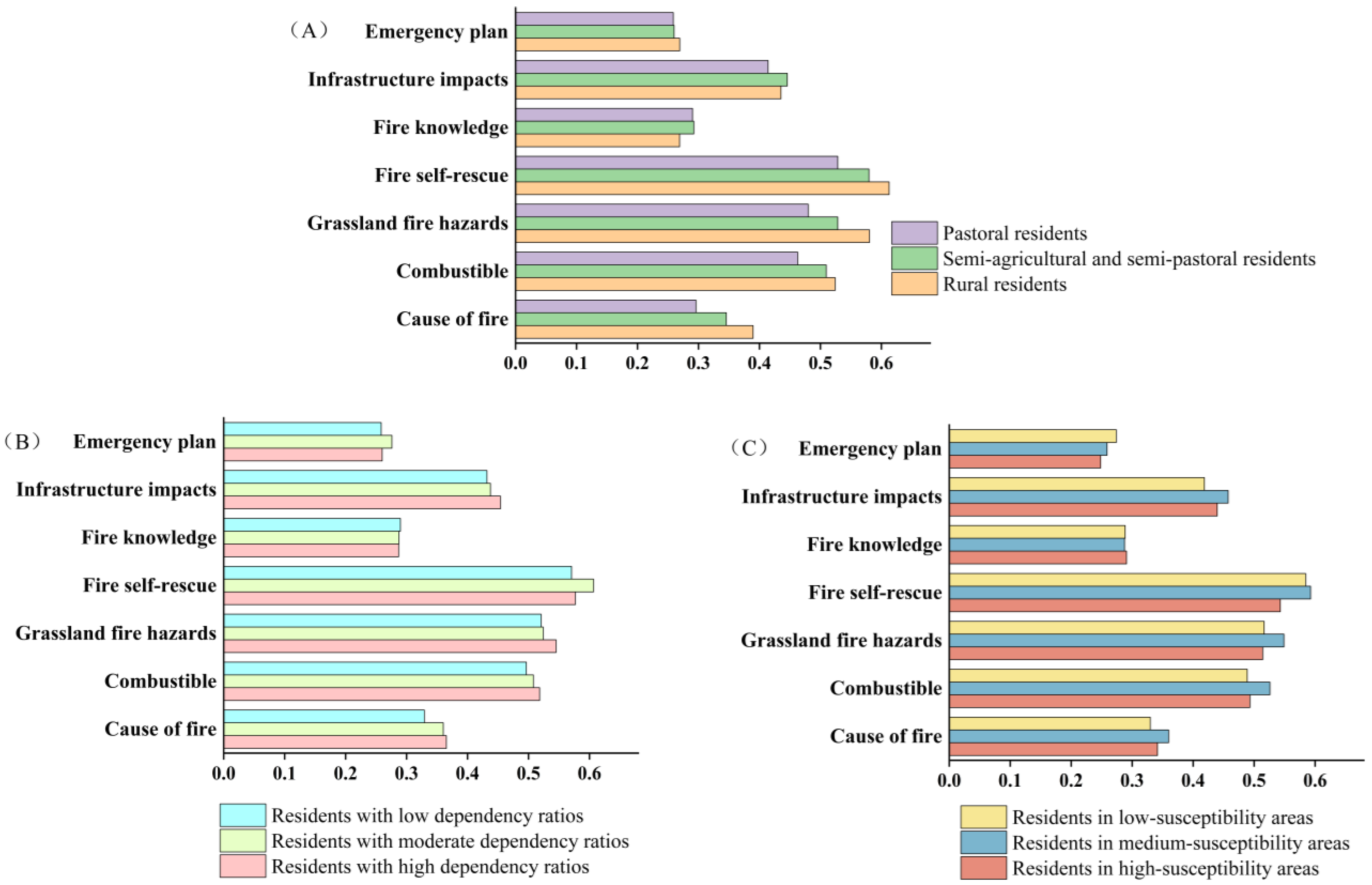
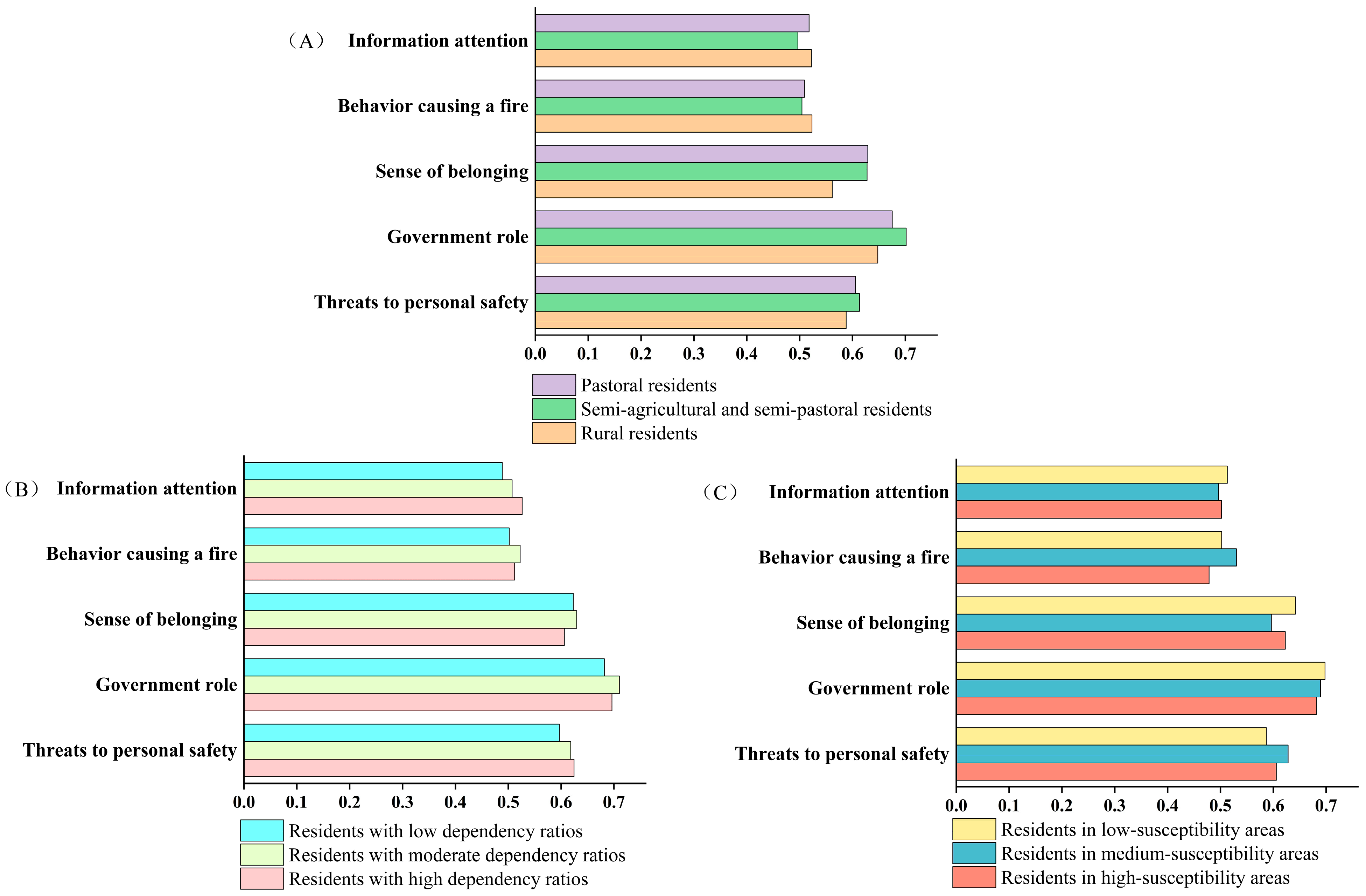
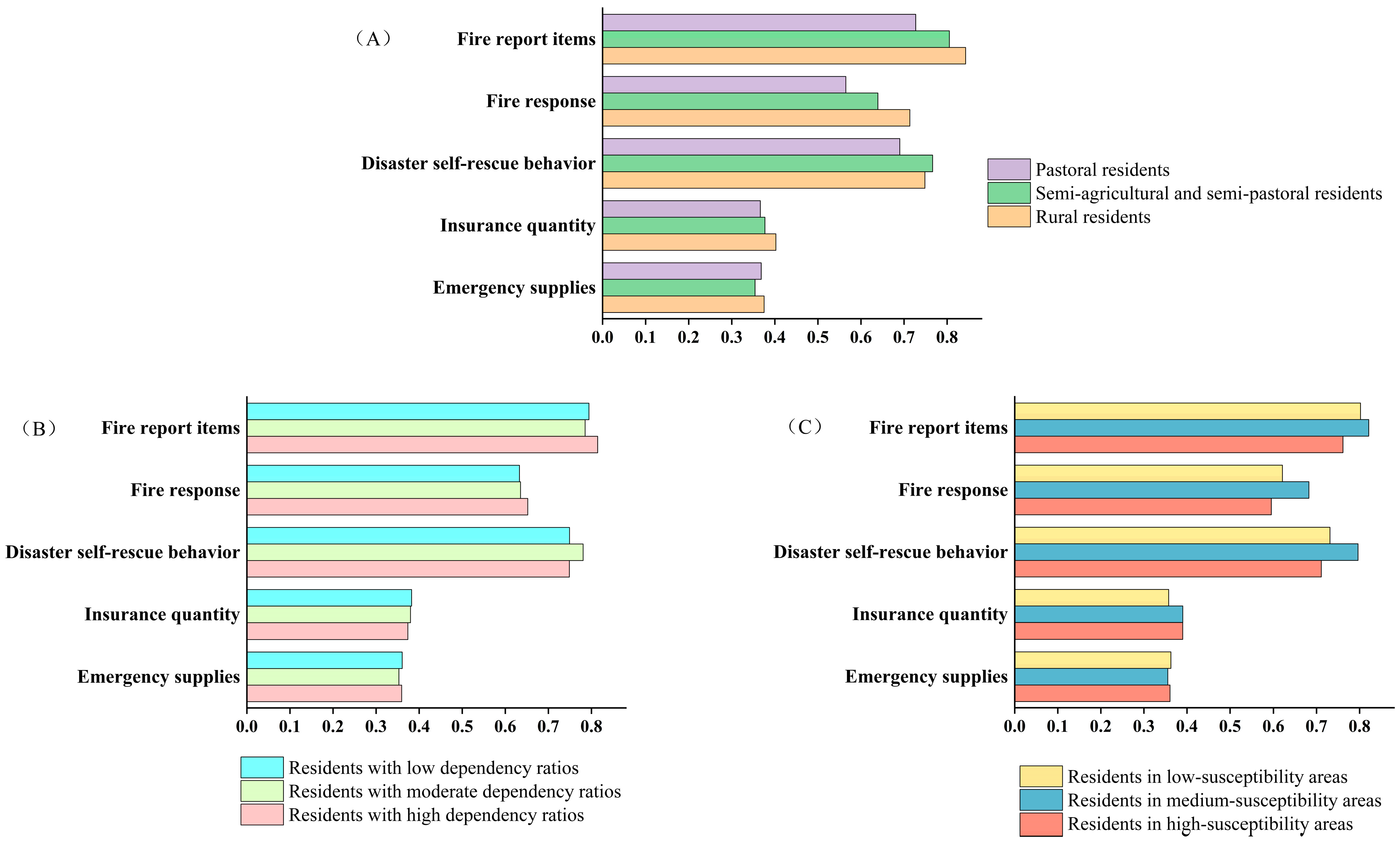
| Primary Indicator | Secondary Indicators | Tertiary Indicators | ||||
|---|---|---|---|---|---|---|
| Indicator | Weighting | Indicator | Survey Question | Question Type | Weighting | |
| Residents’ perception of grassland fire risk | Knowledge related to grassland fires (K) | 0.412 | Cause of fire | (K1) Which of the following do you think are the causes of grassland fires? | MRQ | 0.142 |
| Combustible material | (K2) Which of the following are combustible materials found on grasslands? | MRQ | 0.148 | |||
| Fire hazard | (K3) What are the main hazards of grassland fires? | MRQ | 0.147 | |||
| Fire Self-Rescue | (K4) Do you think the statement about self-rescue in grassland fires is correct? | SRQ | 0.147 | |||
| Fire Safety Knowledge | (K5) How much do you know about grassland fires (firefighting measures)? | SRQ | 0.137 | |||
| Infrastructure impact | (K6) Do you know how much grassland fires affect infrastructure? | SRQ | 0.143 | |||
| Emergency plan | (K7) How familiar are you with emergency response plans? | SRQ | 0.137 | |||
| Attitude toward responding to grassland fires (A) | 0.292 | Threat to personal safety | (A1) How much of a threat do you think grassland fires pose to the safety of your family? | SRQ | 0.200 | |
| Government role | (A2) Should government departments play a greater role in preventing and mitigating grassland fires? | SRQ | 0.204 | |||
| Sense of belonging | (A3) Can families play a greater role in preventing and mitigating grassland fires? | SRQ | 0.202 | |||
| Behavior causing a fire | (A4) Do you think your actions could cause a grassland fire? | SRQ | 0.192 | |||
| Information attention | (A5) How concerned are you about information related to grassland fires? | SRQ | 0.202 | |||
| Grassland fire response behavior (P) | 0.295 | Emergency supplies | (P1) Does your family consciously stockpile emergency supplies? | SRQ | 0.199 | |
| Insurance quantity | (P2) How much insurance do you purchase? | MRQ | 0.191 | |||
| Disaster self-rescue behavior | (P3) If a grassland fire occurs, would you engage in self-rescue and mutual aid among the public? | SRQ | 0.202 | |||
| Fire response | (P4) If you were to experience a grassland fire, what would you do? | MRQ | 0.203 | |||
| Fire Report Items | (P5) When you discover a grassland fire, what should you report? | MRQ | 0.205 | |||
| Dimension | Independent Variable | Variable Interpretation and Assignment | Mean | Standard Deviation |
|---|---|---|---|---|
| Resident characteristics | Level of education (X1) | Illiterate = 1; Elementary school = 2; Junior high school = 3; High school or vocational school = 4; College or university and above = 5 | 2.824 | 0.865 |
| Grassland area (X2) | Grassland area /acre | 393.319 | 2313.510 | |
| Annual household income (X3) | less than 10,000 = 1; 10,000–30,000 = 2; 30,000–100,000 = 3; 100,000–500,000 = 4; and 500,000 or more = 5. | 2.240 | 1.024 | |
| Percentage of household income attributable to livestock farming (X4) | Less than 20% = 1; 20–40% = 2; 40–60% = 3; 60–80% = 4; More than 80% = 5 | 1.990 | 1.260 | |
| Number of grassland fires experienced (X5) | No experience = 1; 1–2 times = 2; 3–4 times = 3; 5–6 times = 4; 7 times or more = 5 | 1.229 | 0.512 | |
| Climate variables | Annual average temperature (X6) | Local average annual temperature/°C | −0.651 | 4.141 |
| Annual precipitation (X7) | Local annual average precipitation/mm | 421.421 | 103.745 | |
| Dryness (X8) | ArcGIS 10.8 extraction of dryness of survey points | 2.314 | 1.094 | |
| Risk communication | Received information on grassland fire conditions and safety measures (X9) | Never received = 1; Rarely received = 2; Sometimes received = 3; Often received = 4; Always received = 5 | 3.288 | 1.343 |
| Title 1 | Explanatory Variable | γ = 0.25 | γ = 0.50 | γ = 0.75 | |||
|---|---|---|---|---|---|---|---|
| Coefficient | t | Coefficient | t | Coefficient | t | ||
| S1 | X1 | −0.003 | −0.565 | 0.003 | 0.57 | 0.006 | 1.114 |
| X2 | −0.000001408 | −0.675 | −0.0000001542 | −0.081 | −0.000001785 | −0.911 | |
| X3 | −0.002 | −0.499 | 0.004 | 1.255 | 0.003 | 1.137 | |
| X4 | −0.002 | −0.437 | 0.001 | 0.145 | 0.000 | 0.067 | |
| X5 | −0.005 | −0.529 | −0.006 | −0.723 | −0.007 | −0.771 | |
| S2 | X6 | 0.006 *** | 4.379 | 0.005 *** | 3.828 | 0.005 *** | 3.601 |
| X7 | 0.000 *** | −4.796 | 0.000 *** | −3.474 | 0.000 *** | −3.289 | |
| X8 | −0.031 *** | −3.579 | −0.026 *** | −3.281 | −0.027 *** | −3.289 | |
| S3 | X9 | 0.028 *** | 7.709 | 0.024 *** | 7.424 | 0.023 *** | 6.79 |
| Sample size | 1188 | 1188 | 1188 | ||||
| Pseudo-R2 | 0.078 | 0.053 | 0.047 | ||||
Disclaimer/Publisher’s Note: The statements, opinions and data contained in all publications are solely those of the individual author(s) and contributor(s) and not of MDPI and/or the editor(s). MDPI and/or the editor(s) disclaim responsibility for any injury to people or property resulting from any ideas, methods, instructions or products referred to in the content. |
© 2025 by the authors. Licensee MDPI, Basel, Switzerland. This article is an open access article distributed under the terms and conditions of the Creative Commons Attribution (CC BY) license (https://creativecommons.org/licenses/by/4.0/).
Share and Cite
Xu, W.; Zhou, Q.; Ma, W.; Liu, F.; Niu, B.; Li, L. Study on Qinghai Province Residents’ Perception of Grassland Fire Risk and Influencing Factors. Fire 2025, 8, 371. https://doi.org/10.3390/fire8090371
Xu W, Zhou Q, Ma W, Liu F, Niu B, Li L. Study on Qinghai Province Residents’ Perception of Grassland Fire Risk and Influencing Factors. Fire. 2025; 8(9):371. https://doi.org/10.3390/fire8090371
Chicago/Turabian StyleXu, Wenjing, Qiang Zhou, Weidong Ma, Fenggui Liu, Baicheng Niu, and Long Li. 2025. "Study on Qinghai Province Residents’ Perception of Grassland Fire Risk and Influencing Factors" Fire 8, no. 9: 371. https://doi.org/10.3390/fire8090371
APA StyleXu, W., Zhou, Q., Ma, W., Liu, F., Niu, B., & Li, L. (2025). Study on Qinghai Province Residents’ Perception of Grassland Fire Risk and Influencing Factors. Fire, 8(9), 371. https://doi.org/10.3390/fire8090371






